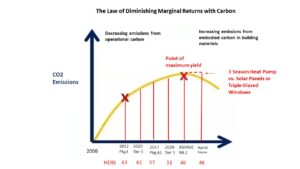
Understanding the Law of Diminishing Returns: The Best Practice
“The law of diminishing returns means that even the most beneficial principle will become harmful if carried far enough.” — Thomas Sowell
Energy performance was introduced under SB-12 in 2012, then again at 15% better in 2017 and, very shortly, we are expecting harmonization with the National Building Code (NBC) in March 2024. Currently the Ministry of Municipal Affairs and Housing (MMAH) is proposing to adopt Tier 3 of the NBC (roughly 8% higher than Package A1), and policy makers are targeting net zero by 2030.
An important question is: where does the law of diminishing returns kick in? See graph. Ironically, the most popular programs — like net zero or Passive House — were conceived before we started accounting for embodied carbon. Building components like triple-glazed windows, certain types of insulation and concrete can also negate these emission reductions. Early experiences show that electric NZE houses cost more to operate.
Where is the sweet spot? Is net zero a reasonable goal? Time will tell. Wood is renewable and, best of all, is a carbon sink. Trees produce oxygen and absorb CO2. Using wood in large building structures replaces concrete and steel and thus reduces the largest sources of embodied carbon in buildings.
Triple-glazed windows could be the last choice depending on a home’s size, orientation and climate. A low solar heat gain coefficient may be a more important value for comfort and efficiency than an extra pane of glass.
It has been said that the road to hell is paved with good intentions. Using more embodied carbon to save operational carbon is just adding fuel to the fire. With diminishing time and resources in a period of climate change, finding the point of diminishing returns is of utmost importance.
